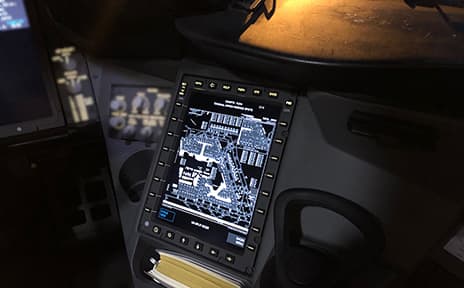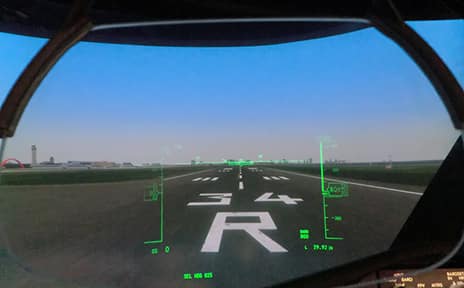
Interview10-Feb-22
Unforgettable memories created by the 787
Captain Takuya Komada was involved in training operations as an initial instructor for the Boeing 787 (hereinafter 787) as well as the inauguration of new routes.
"My first encounter and impression of the 787"
Captain Komada's first encounter with the 787 was through a video. His impression of the 787 at that time was, "What a beautiful form with its thin, long wings flexing beautifully." He remembers watching the video of the 787, shot from the front, making a spectacular approach to the runway, and being very excited as he imagined himself flying it, wondering what it would be like.
ANA's 787 regular flight service was delayed for several years from the original schedule. However, the decision was made to start the service in the fall of 2011, and the training of about 40 initial instructors called "Pioneers" of the 787, started at the beginning of that year. Captain Komada was one of the members of the second group, following the first group of those who were transitioning from the 777 to the 767.
He looks back on that time and says, "When I was nominated for the position, I couldn't help but jump for joy. It was as if I had won the lottery," he said. He says he has never won a lottery, but he expects the level of excitement would be similar.
ANA did not have instructors based in Japan to train the "Pioneers'' who would become the initial instructors for the 787. The training was held in Seattle, Boeing's home, starting partway through the ground training. Because it was a new aircraft model, they had only seen videos and photos of it in training materials, and rarely saw the actual aircraft up close.
One day, when he went for a jog in between training sessions, he looked up and saw a 787 on a test flight. Looking back, that was the first time he saw a real 787, and at the time, he wondered, "Is that the 787? Can I fly that?" Pilot training is mostly conducted using simulators, so it was rare to have a chance to see the aircraft up close.

(Captain Komada on the far right)
One day in the second half of July, during a break in training, Boeing took the "Pioneers" to the airframe factory to see the aircraft being built.
"I just remember being so excited like a kid and thinking that this thing would soon be flying over Japan and we would be flying it."
He was in awe by the overpowering presence of the 787 in front of him and felt a surge of excitement. Later, he experienced actual flight training in Seattle and Moses Lake, but it was a test aircraft, and the cabin was filled with a weighted water tank called a ballast, a large number of technical staff collecting flight data, and inspection equipment, so it could not be considered a completed passenger aircraft.
The first time he saw the so-called "newest passenger aircraft 787" was on September 28, when he returned to Japan after his training, and he was impressed with the perfectly prepared cabin specifications and "how beautifully it was made."
There was a press event where the first aircraft with special livery was placed in the hanger and Captain Komada was in charge of showing media personnel around the cockpit. While explaining the aircraft, he nostalgically said, "It's amazing to see how far the aircraft has evolved compared to other aircraft I've flown on," and explained the high level of performance and safety of the aircraft.
"The 787 supports ANA's international network."
The 787, which entered service as the first scheduled domestic flight on November 1, 2011, and began scheduled international flights in January 2012, is currently ANA's main fleet of 77 aircraft, connecting 39 destinations around the world and playing a central role in ANA's international network.
Captain Komada has been in charge of route training for the initial instructors from the beginning and has boarded many of the new routes to establish stable operations. As a result, he often flew to various cities around the world. "As far as I know, I think the 787 has been exposed to the most water cannons at ANA, or even the world," he says. True to form, the 787 was the driving force behind ANA's expansion of its network in the 2010s.

ANA, which had been operating regular international flights since 1986, had already extended its network to major cities in various areas and countries with the 747 and 777. However, the 787, a mid-sized aircraft that makes full use of lightweight and strong carbon fiber materials and significantly reduces fuel consumption, has made it possible to serve "secondary" mid-sized cities.
In those destinations, people had never heard of the Japanese airline, " ANA," and were surprised to learn that this nameless airline was bringing in a state-of-the-art Boeing aircraft.
"The Boeing 787, still a rarity in the world, was warmly and curiously welcomed at airports around the world."
Upon landing at various airports around the world, he was greeted in many ways including being guided by the control tower through an unusual and circuitous taxiway where he made a "triumphant" return to many fans and airport staff who had come to see the aircraft, as well as being met at the arrival spot by a large group of ground crew members from other companies, and exposed to a sea of camera flashes.
"It was one of the best moments I've ever had as a pilot. When I waved from the cockpit, I felt like I was a hero in a movie (laughs)."

"787 allowed me to meet so many people."
As a route training instructor, Captain Komada was responsible for training the pilots who would be transitioning to the course after him.
"Of course, as an instructor and mentor, I don't have a lot of experience flying the 787 since it is a new model. Especially in the early days, rather than instructing piloting techniques, it was more a matter of experiencing the aircraft together and sharing the new systems and navigation techniques. Therefore, I often communicated more deeply with the pilots in the transition course."
The relationship between the instructors and trainees was more than that of instructors and trainees, as they worked together to build up the 787 training program through actual flight experience.
In addition, small problems would naturally arise during flight operations, so communication with mechanics was also carefully conducted. While the 787 has an image of being a beautiful airplane, as a pilot, he continued to study while interacting with various people every day.
Moreover, he experienced not only operations of the aircraft but also had the opportunity to encounter so many people because of the state-of-the-art 787 aircraft.
In general, the primary and most important mission of a pilot is to get passengers to their destinations safely, comfortably, and on time, and the number of people they meet outside of regular operations is limited.
In new destinations, however, he was able to connect with the airport and sales staff who welcomed him. When he went out to eat with the local staff, he asked them,
"'Is there any way to make the route more exciting so that people will know about it?' I was even asked for advice on how to grow the route," he said with a laugh.
In addition, the 787 was used as a flight to support the recovery from the Great East Japan Earthquake that struck in March 2011, and children from Miyagi and Fukushima prefectures were invited to take part in a trial flight. Having flown both events, Captain Komada was involved with not only the ANA staff but also the CAB (Civil Aviation Bureau), prefectural officials, airport company officials, and the children on board.
"I am very lucky to have met so many people through the 787, and it has been a gratifying and valuable experience for me. I think I was able to grow not only as a pilot but also as a person. In particular, through the initiatives I experienced with the ANA Group staff, I also realized the quality of our company once again, and I came to love my colleagues who are passionate about what they do. This is one of the things I wanted to talk about today," Captain Komada reflected sincerely.
"The 787 after 10 years in service"
"It has been ten years since the start of service, but we have had some problems with batteries and engines, which have caused some inconvenience to our customers." When asked how he felt about the first ten years of the airline's operation, Captain Komada quietly answered.
"As the launch customer of this new aircraft, it wasn't expected to be perfect from the start. As we continue to operate the aircraft, some initial problems will appear. We, the pilots, continue to train every day and we want to reassure passengers that we will get the aircraft off the ground safely, but we are very sorry when there are delays or cancellations due to problems. Don't get me wrong but, those problems were great opportunities for us to learn more about the 787 as we were able to delve into it more professionally, and I feel that we learned and grew together a lot."
The most important thing for a passenger aircraft operation is safety. Once an accident occurs, economic efficiency, fuel efficiency, and in-flight comfort will lose its meaning. In this sense, we can say that ANA was chosen by Boeing as the launch carrier for the 787 and that ANA did not disappoint the expectations of Boeing.
Captain Komada concluded by saying, "I believe that ANA's pilots and operations support team, especially the maintenance team, were able to greatly contribute to the growth of the 787 airplanes and its development into a greater aircraft."
Profile
Takuya Komada
Captain 777/787, ANA
Joined ANA in 1992. Trained at the Kumamoto Airport Training Center after initial ground crew training. In 2004, became 767 co-pilot, 747-400 co-pilot, and 767 captain. In September 2010, he received an order to switch to the 787. He is involved in pilot training as a route instructor captain. Currently flying two types of aircraft, Boeing 787 and 777, and is Deputy General Manager of ANA Boeing 787 Department.






 facebook
facebook
 X
X YouTube
YouTube Instagram
Instagram LinkedIn
LinkedIn